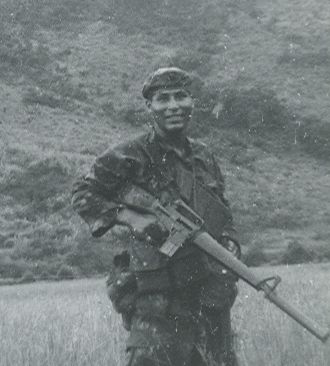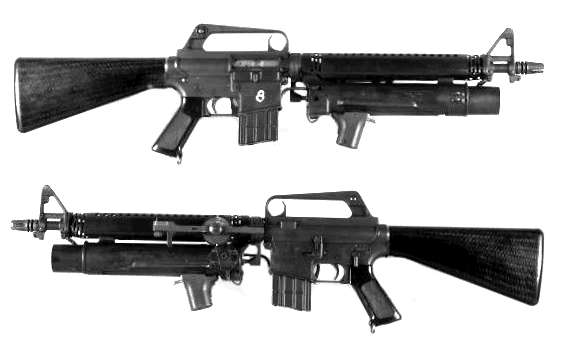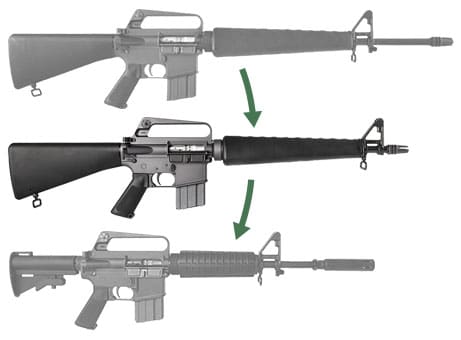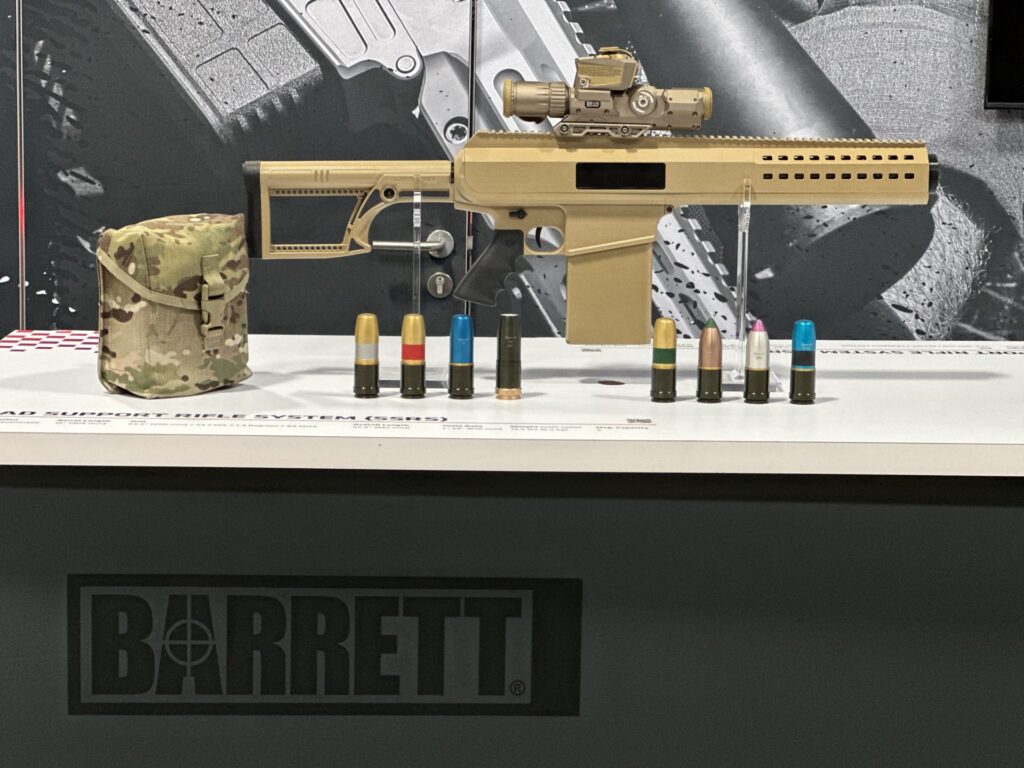The first AR carbine – The Colt 605 Dissipator
- By Travis Pike
Share This Article

Vietnam was a crazy time for weapon development. We saw a lot of new concepts arrive that are still used today, among these is the use of shorter, lighter carbines as service rifles. In fact, the CAR-15 became one of the most famous special operations rifles during the Vietnam war. However, it wasn’t the first. The Colt 605 “Dissipator” would technically be the first carbine of the M16 and AR-15 series rifles.
The M16 provided a much lighter and shorter rifle than ever before. Yet, even so, it was often found to be too long for the thick jungles of Vietnam. For normal infantry, it was an inconvenience, but for special operations, it could be a death sentence. The need for lighter, shorter rifles was very real, and from that need, Colt developed the Model 605 Dissipator rifle.
What’s a dissipator?
Honestly, it’s been tough to figure out where the name Dissipator came from. Colt never called the 605 that. The first use of the term seems to come from Bushmaster, who produced commercial variants that utilized the 605’s design theme. The name seems to come from the heavy handguards with integral metal shields that dissipated heat; somehow it got attached to this style of rifle.

According to this style, a 20-inch barrel is used but is trimmed down significantly. Due to the NFA, the Bushmaster and other commercial variants use a 16-inch barrel, but the original Colt 605 rifles utilized a 15-inch barrel.
Trimming down 25 percent of the barrel made for a significantly shorter rifle. Yet, the gas system, front, and handguard, and even the stock remained the same from the M16 series of rifles. Not a bad idea, and it could be done easily, affordably, and provide troops overseas with a carbine variant that excelled in the jungle.
In the tight confines of the jungle most of the fighting was close quarters. In close quarters smaller weapons dominate due to their improved maneuverability. Additionally, special ops commandos often operated with very little support, and they needed all the advantages they could get. A smaller rifle helped small teams remain stealthy deep in the jungle.

A big long barrel could easily snag a tree, limb, or vine and create a ruckus. Reading some accounts from SOG guys, it seems they silenced everything they possibly could. From dog tags to canteens, they silenced it all. If a shorter rifle could help them maintain stealth and be more dominant in a fight, then it seems like a win-win.

Related: The special operations helicopters of the Vietnam War
What happened to the dissipator?
So if the Dissipator offered a shorter carbine-like rifle, why has no one ever really heard of it? Well, that’s a solid question. We know the idea stuck around because the M4 carbine currently rules the roost of military rifles. Heck, we also know that the CAR-15 saw lots of action in Vietnam, and along the way, a number of carbines came and went throughout the Cold War.
The Dissipator had a big problem, however, and that was reliability. Cutting off five inches of barrel killed the rifle’s dwell time. Dwell time is the amount of time the bullet stays in the barrel, past the gas port. The Dissipator had very little barrel length past the gas port.

Future carbines reduced the gas system from a 12-inch rifle length gas tube to a 7-inch carbine to increase dwell time and reliability. Today the issue is solved by expanding the gas port as a few commercial manufacturers have done. Rifles like the Mk18 use a carbine-length gas system with a larger gas port to ensure reliability, even though they have a very short dwell time.
In the few pictures you see in Vietnam, you’ll notice that most Dissipator guns wear suppressors. Suppressors increased back pressure which would make the Dissipator more reliable and would essentially have the same effect as a larger gas port.
Advantages of the Colt 605
Obviously, the Colt 605 rifles trimmed some length and weight, but if they had been built properly with the knowledge of today, they might have stuck around a little longer. The Dissipator allows for longer handguards which offer more mounting space and allow for more control over the weapon.
On top of that, the sight radius is the exact same as the M16 and much longer than the CAR-15 and later M4 models. A longer sight radius makes the weapon easier to fire accurately. Although, in modern weapons, the presence of optics made this much less of an issue.

Finally, the Colt 605 used a rifle-length gas system. If the port was expanded a bit for reliable cycling, this rifle-length gas system would provide the size of a carbine with less of a recoil. Rifle-length gas systems in the M16 series are notoriously smooth, and even with an open port, it’d be much smoother than a carbine-length system.
To this day, the idea of a longer gas system as a better option is being explored. NSWC-Crane has been conducting long terms tests with commercial 9-inch mid-length gas systems in M4 carbines.
Will it come back?
In the military it’s time has passed, and the M4 carbine rules the roost. Yet, in the commercial market, Dissipator builds have a cult following. However, most use a mid-length gas system over a rifle-length system.
The Colt 605 and the “Dissipator” are long past relevant for a modern military, but they are an interesting step on the road to the M4.
Read more from Sandboxx News
Related Posts
Sandboxx News Merch
-

‘AirPower’ Classic Hoodie
$46.00 – $48.00 Select options This product has multiple variants. The options may be chosen on the product page -

‘Sandboxx News’ Trucker Cap
$27.00 Select options This product has multiple variants. The options may be chosen on the product page -

‘Sandboxx News’ Dad Hat
$27.00 Select options This product has multiple variants. The options may be chosen on the product page

Travis Pike
Travis Pike is a former Marine Machine gunner who served with 2nd Bn 2nd Marines for 5 years. He deployed in 2009 to Afghanistan and again in 2011 with the 22nd MEU(SOC) during a record-setting 11 months at sea. He’s trained with the Romanian Army, the Spanish Marines, the Emirate Marines, and the Afghan National Army. He serves as an NRA certified pistol instructor and teaches concealed carry classes.
Related to: Military History

The Switchblade, loitering munitions, and the new terrifying face of warfare

5 ways to prepare and survive the Marine Corps boot camp

Barrett’s Squad Support Rifle System will make infantry squad deadlier
Sandboxx News
-

‘Sandboxx News’ Trucker Cap
$27.00 Select options This product has multiple variants. The options may be chosen on the product page -

‘AirPower’ Classic Hoodie
$46.00 – $48.00 Select options This product has multiple variants. The options may be chosen on the product page -

‘AirPower’ Golf Rope Hat
$31.00 Select options This product has multiple variants. The options may be chosen on the product page -

‘Sandboxx News’ Dad Hat
$27.00 Select options This product has multiple variants. The options may be chosen on the product page
